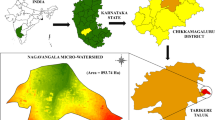Abstract
Soil data obtained from soil resource inventory, land and climate were derived from the remote sensing satellite data (Landsat TM, bands 1 to 7) and were integrated in GIS environment to obtain the soil erosion loss using USLE model for the watershed area. The priorities of different sub-watershed areas for soil conservation measures were identified. Land productivity index was also used as a measure for land evaluation. Different soil and land attribute maps were generated in GIS, and R,K,LS,C and P factor maps were derived. By integrating these soil erosion map was generated. The mapping units, found not suitable for agriculture production, were delineated and mapped as non-arable land. The area suitable for agricultural production was carved out for imparting the productivity analysis; the land suitable for raising agricultural crops was delineated into different mapping units as productivity ratings good, fair, moderate and poor. The analysis performed using remote sensing and GIS helped to generate the attribute maps with more accuracy and the ability of integrating these in GIS environment provided the ease to get the required kind of analysis. Conventional methods of land evaluation procedures in terms of either soil erosion or productivity are found not comparable with the out put generated by using remote sensing and GIS as the limitations in generating the attribute maps and their integration. The results obtained in this case study show the use of different kinds of data derived from different sources in land evaluation appraisals.
Similar content being viewed by others
References
Beek, K.J., Bie K De and Driessen, P. (1997). Land information and Land Evaluation for land use planning and sustainable land management.Land Chatham,1: 27–44.
Fresco, L.O. (1990). Using land evaluation and farming systems methods for planning sustainable land use - an example from Costa Rica, Land use planning Applications. Proceedings FAO Expert consultation, Rome, 10-14 Dec 1990. World Soil resources - Reports, No. 68, 1991, pp. 153–157.
Krishna, A.P. and Sharma, E. (1995). Environmental impact assessment of dynamic anthropogenic activities in Mamlay watershed of Sikkim Himalaya - A remote sensing Approach.Asian - Pacific Remote Sensing. J. 8(1): 23–28.
Lanen Van, H.A.J., Diepen Van, C.A., Reinds, G.I. and Koning, G.H.J. (1992). Physical land valuation methods and GIS to explore the crop growth potential and its effects within the European communities.Agricultural Systems 38(3): 307–328.
Merolla, Sivia, Mesto, Griseda, Calvanese and Gustavo. (1994). AGIS application for assessing agricultural land.ITC J.,3: 264–269.
Moore, I.D. and Wilson, J.P. (1992). Length - slope factors for the revised Universal soil Loss Equation: simplified method of estimation.J. of Soil and Water Conservation,45(5): 423–428.
Rao, D.P., Gautam, N.C., Nagaraja, R. and Ram Mohan, P. (1996). IRS-IC application in land use mapping and planning.Current Science,70: 575–578.
Rossiter, G.D. (1996). A theoretical frame work for land evaluation.Goederma,72: 165–190.
Saha, S.K., Bhattacharjee, C. Laeangzuva and Pande, L.M. (1992). Prioritization of sub - watersheds based on erosional loss estimation - A case study of part of Song river watershed, Doon valley using satellite data. Proc. National Symposium on Remote Sensing for Sustainable Development, pp. 181–186.
Sharma. E.R.C., Sundriyal, Y.K. Bhatt, L.K. Rai., Sharma, R. and Rai, Y.K. (1992). Integrated Watershed Management: A case study in Sikkim Himalaya, Gynodaya Prakashan, Nainital, India, pp.4–11.
Storie, R.E. (1978). Storie index soil rating (revised). Special Publication. Div of Agricultural Sciences No. 3203. Univ of California, Berkeley, CA.
Wischmeier, W.H and Smith, D.D. (1978). Predicting rainfall erosion losses — A guide for conservation planning. USDA- SEA Agriculture handbook, 537, U.S. Department of Agriculture, pp. 1–22.
Author information
Authors and Affiliations
Corresponding author
About this article
Cite this article
Martin, D., Saha, S.K. Integrated approach of using remote sensing and GIS to study watershed prioritization and productivity. J Indian Soc Remote Sens 35, 21–30 (2007). https://doi.org/10.1007/BF02991830
Received:
Revised:
Issue Date:
DOI: https://doi.org/10.1007/BF02991830




